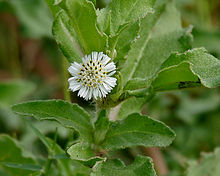Eclipta prostrata
| Eclipta prostrata | |
|---|---|

| |
| Scientific classification | |
| Kingdom: | |
| (unranked): | |
| (unranked): | |
| (unranked): | |
| Order: | |
| Family: | |
| Genus: | |
| Species: | E. prostrata
|
| Binomial name | |
| Eclipta prostrata | |
| Synonyms | |
|
Synonymy
| |
Eclipta prostrata commonly known as false daisy, yerba de tago, Karisalankanni , and bhringraj, is a species of plant in the sunflower family. It is widespread across much of the world.[3][4][5]
This plant has cylindrical, grayish roots. The solitary flower heads are 6–8 mm (0.24–0.31 in) in diameter, with white florets. The achenes are compressed and narrowly winged.

This species grows commonly in moist places in warm temperate to tropical areas worldwide. It is widely distributed throughout India, Nepal, China, Thailand, and Brazil.
Traditional uses



The plant has traditional uses in Ayurveda. It is bitter, hot, sharp, and dry in taste. In India, it is known as bhangra or bhringaraj. Wedelia calendulacea is known by the same names, so the white-flowered E. alba is called white bhangra and the yellow-flowered W. calendulacea is called yellow bhangra.[6]
In Southeast Asia, the dried whole plant is used in traditional medicine,[7] although there is no high-quality clinical research to indicate such uses are effective.
Phytochemistry
Eclipta prostrata contains various phytochemicals, such as coumestans, polypeptides, polyacetylenes, thiophene derivatives, steroids, sterols, triterpenes, and flavonoids.[8]
References
- ^ Lansdown, R.V.; Beentje, H.J. (2017). "Eclipta prostrata". IUCN Red List of Threatened Species. 2017: e.T164051A121894451. doi:10.2305/IUCN.UK.2017-3.RLTS.T164051A121894451.en.
{{cite journal}}: Unknown parameter|last-author-amp=ignored (|name-list-style=suggested) (help) - ^ "Eclipta prostrata (L.) L." The Plant List version 1.1. Retrieved 26 January 2014.
- ^ Flora of North America, Eclipta Linnaeus, Mant. Pl. 157, 286. 1771.
- ^ Flora of China, 鳢肠 li chang Eclipta prostrata (Linnaeus) Linnaeus, Mant. Pl. 2: 286. 1771.
- ^ Altervista Flora Italiana, Falsa margherita , false daisy, tattoo plant, Eclipta prostrata (L.) L.
- ^ Puri, H. S. 2003. Rasayana: Ayurvedic Herbs for Longevity and Rejuvenation. Taylor & Francis, London. pages 80–85.
- ^ Nantana Sittichai; Chayan Picheansoothon, eds. (2014). Herbal Medicines Used in Primary Health Care in ASEAN. Department for Development of Thai Traditional and Alternative Medicine. p. 148–149. ISBN 9786161122119.
- ^ Chung, I. M; Rajakumar, G; Lee, J. H; Kim, S. H; Thiruvengadam, M (2017). "Ethnopharmacological uses, phytochemistry, biological activities, and biotechnological applications of Eclipta prostrata". Applied Microbiology and Biotechnology. 101 (13): 5247–5257. doi:10.1007/s00253-017-8363-9. PMID 28623383.
Further reading
- Everitt, J.H.; Lonard, R.L.; Little, C.R. (2007). Weeds in South Texas and Northern Mexico. Lubbock: Texas Tech University Press. ISBN 0-89672-614-2
- Caldecott, Todd (2006). Ayurveda: The Divine Science of Life. Elsevier/Mosby. ISBN 0-7234-3410-7.

